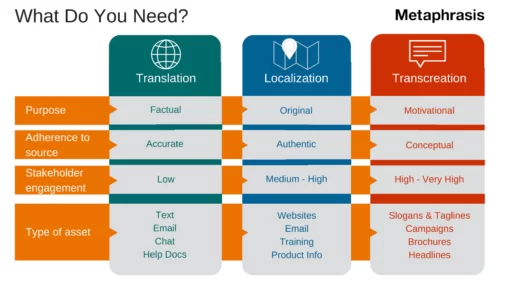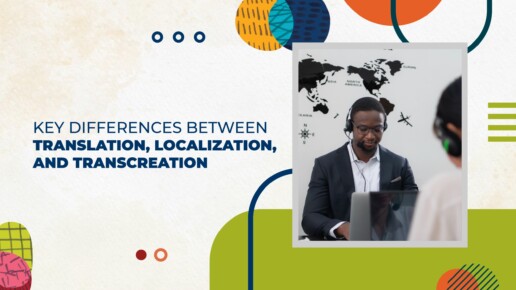In an increasingly interconnected world, language has become the gateway to reaching global audiences. Whether you’re expanding your business internationally or connecting with diverse communities, the need for adapting content across languages and cultures has never been greater. But not all language services are created equal. Understanding the differences between translation, localization, and transcreation is essential to ensure that your message resonates with the right audience. At Metaphrasis Language & Cultural Solutions, we specialize in helping clients choose the right approach for their needs.
Let’s explore these key services and when to use each.

What is Translation?
Translation is the process of converting written content from one language into another. The primary goal is to maintain the original meaning while ensuring linguistic accuracy. Whether you’re translating legal documents, user manuals, or technical guides, the content must remain faithful to the original text.
For example, translating an employee handbook from English to Spanish requires the same attention to detail, ensuring that all policies, procedures, and guidelines are conveyed clearly in the new language.
When to Use Translation
Translation is ideal for content that doesn’t rely heavily on cultural nuances or emotional impact. It’s perfect for:
- Legal documents
- Technical manuals
- Medical
- Business contracts
By choosing Metaphrasis, you ensure that your translated content maintains its integrity and clarity across languages.
What is Localization?
Localization takes translation a step further by adapting content to fit the cultural, legal, and regional specifics of the target audience. It’s not just about changing words—it’s about making sure the content feels natural to the local market.
Imagine you’re launching an eCommerce site in France. Localization would involve adjusting everything from currency and date formats to ensuring that the imagery, colors, and even product descriptions align with French cultural norms and preferences.
Key Elements of Localization
- Cultural Relevance: Adjusting content to reflect local customs, holidays, and traditions.
- Legal Compliance: Adapting to regional laws and regulations, such as GDPR for Europe.
- User Preferences: Modifying language to fit local idioms, slang, and linguistic preferences.
At Metaphrasis, our localization experts ensure that your content resonates with your target audience on a deeper level, increasing engagement and brand loyalty.
What is Transcreation?
Transcreation is a creative process that involves reimagining content to evoke the same emotions and tone as the original, but tailored for a new audience. It’s commonly used in marketing and advertising, where the goal is not just to translate but to adapt the message so it has the same impact in a different cultural context.
For instance, a slogan or tagline that works well in the US might not resonate in Japan. With transcreation, we would adapt the slogan to make sure it reflects cultural preferences while still aligning with your brand’s identity.
When to Use Transcreation
Transcreation is the best option when you need to preserve the emotional or persuasive elements of your content. It’s often used for:
- Marketing campaigns
- Brand messaging
- Advertising slogans
- Social media content
At Metaphrasis, we work closely with your creative team to ensure that the core message of your brand remains intact, while also adapting it to speak directly to your new audience.
Choosing the Right Service
So, how do you know whether your project needs translation, localization, or transcreation? Let’s break it down.
When Translation is Enough
If your content is factual, technical, or legal, and you’re only concerned with accuracy, translation will meet your needs. This includes:
- Instruction manuals
- Contracts
- Medical reports
When Localization is Essential
If your content requires regional customization, such as for websites, software, or product descriptions, localization is crucial. Localization ensures that your content feels local, not foreign, to your target market.
When You Need Transcreation
For creative projects where maintaining the emotional connection and brand identity is essential, transcreation is the best option. This is especially important for global marketing campaigns, where the goal is to inspire, persuade, or entertain across cultures.
The Challenges of Each Approach
Each approach comes with its own set of challenges, and it’s important to understand them:
Translation Challenges
- Maintaining linguistic accuracy without sacrificing readability.
- Dealing with idiomatic expressions that don’t translate well between languages.
Localization Challenges
- Navigating cultural differences and ensuring the content resonates with the target audience.
- Ensuring legal compliance and meeting regional regulations.
Transcreation Challenges
- Striking a balance between staying true to the original message and adapting it creatively for a new culture.
- Preserving the emotional and persuasive impact across different languages.
At Metaphrasis, we’re experienced in navigating these challenges and delivering tailored language solutions that ensure your message reaches your audience effectively.
Conclusion
Understanding the key differences between translation, localization, and transcreation is essential for businesses looking to expand their global reach. Whether you’re translating legal documents, localizing a website for a new market, or launching a global marketing campaign, choosing the right approach will determine your success. At Metaphrasis Language & Cultural Solutions, we’re here to help you navigate this process and find the best solution for your unique needs.
By tailoring your content to fit the linguistic and cultural preferences of your audience, you not only reach more people—you connect with them on a deeper level.

